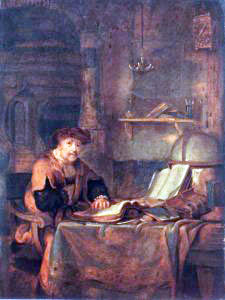- Home
- Index
-
My Books
- Book List
- Writing/Reading Articles Listing
-
My Short Stories
- What God Lost
- What God Lost — Part 2
- When Hope Was Lost
- A Battle in the Heavens
- To Live Forever
- Finding Peace
- Empty Hands
- From Fire and Thunder to Love and Submission
- The Coming One
- Forgiveness Made Possible
- The Innkeeper's Wife
- Do You Have The Right Words?
- The Lamb of God As Told by a Scribe
- What Love Is This?
- When Heaven Came Down
- Family
- Faith

Home Furnishings
by Guest Speaker Professor Carol Reynolds
I read Professor Carol Reynold's article through Jim and Randy Weiss's newsletter. She graciously permitted me to reprint it here for you. While requesting permission, I found her website full of resources for music and art classes. See link at bottom of article for details.

Since we sold our ranch two years ago, we have been in transition. We presently live in what I like to call a Texas McHouse: one of these huge houses with an open floor plan, 28-ft ceilings, and more granite than anybody needs. It’s nestled in the center of a large, cookie-cutter development and, while not exactly our style, it came along at the right time to meet the right needs.
The neighborhood itself is highly cosmopolitan with many multi-generational families. Even when the neighbors share ethnicities, they do not necessarily share a language. We grandmas do a lot of smiling and gesticulating as we band together to look out for the neighborhood’s kids.
And there are a lot of kids! Though vastly different, the neighborhood reminds me of streets from my childhood. Starting around 3 p.m., children play outside or roam freely between the houses. Since the former residents left a fabulous swing set in our backyard (with fort and climbing wall), let’s just say our address is pretty popular.
Nearly all of the houses share the same floor plan, so imagine my surprise when one of our young visitors said, “I really like the way your house is built, Mrs. Reynolds.”
I raised my eyebrows because our house mirrors his. A second boy, a bit older, chided him with that fact: “That’s stupid.” (Why do kids say this?) “This house is built just like yours.”
“Nuh-uh!” he shot back.
So the three of us began to parse the situation. True, his house has a back patio where ours has a sunroom. But everything else is laid out the same.
Still, the facts weren’t winning the argument. He continued to maintain that our house was built very differently.
Finally he said why. “It’s these,” he beamed, pointed to the continuous row of bookcases that line our main room. “Your house has these,” he said triumphantly. “And these,” he added, pointing to the paintings that fill whatever wall is left. “And that stuff too,” he concluded, indicating the corner filled by the piano and an overflow of music books. “My house doesn’t have any of these parts.”
His more worldly playmate explained that such objects were not architectural features built into the structure, but, rather, possessions that we, the Reynolds family, had brought with us when we moved in.
Both boys then expressed astonishment that someone could actually own so many bookcases, not to mention the books that filled them up. I didn’t have the heart to tell him about the books and paintings filling the rooms he hadn’t seen, or still in boxes in the garage.
This child’s observations have not left my thought. To him, our house was “built better” because he was surrounded with objects of learning and beauty. These presented an atmosphere different than his own home.
And he was right. Most kids in this neighborhood have access to every imaginable piece of technology. But a goodly number of them seem to lack the objects that, to us, bring the most meaning to life.
When these kids come over, they exhaust themselves on the swing set. But then they tend to plop on the sofa and talk to me. Often we open the atlas or scoot the standing globe over so we can talk about geography. Or I direct them to pull out “the third book, second case, bottom row” to illustrate a point that comes up with a specific art folio or musical score. Sometimes I read aloud to them: classic poems, primarily, which seem to delight them. Or we resort to silly jokes and riddles.
But encompassing all that we do is a tapestry of books, paintings, and instruments. They feel those influences.
Implements of learning and creativity are the furnishings our souls seek. I will never forget this boy’s wistful assessment of how nicely our house is built. Clearly his soul is searching for beauty. I hope I can continue to help him find it.
You can learn more about Professor Carol Reynolds at professorcarol.com
Photo: Painting by Gerbrand van den Eeckhout, Scholar with His Books (17th century)
Share with friends!
No comments found
Reading
Find more articles about reading here:
Why Read Fiction?
The Danger of The Wrong Story
Using Stories To Teach Lessons
Reading Chair Worth Using
What Do You Read When You Need Refueled?
Worth Reading
Home Furnishings
The Home Library: A Source of Peace, Calm and Security
My Utmost for His Highest
Reading: It's for Your Children
What Kind of Library Are You Building?
Book List: What Every Boy Wants To Read
The Bible with a Heart
Stressed? Read a Book
Books that Influence
What Is a Good Book?
Escape for a Moment of Time
What Is Fiction Good for?
The Case for Good Taste in Children's Books
What Should Fiction Do?
What Does a 5-Star Book Mean?
Don't Judge a Book by Its Cover
Treasures To Explore
Writing Articles
Find more articles here:
Why I Write
The Face that Shows
Do You Believe in Yourself?
The Publishing Process
Calling All Reviewers!
How Can You Help?
